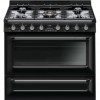Smeg TRU36GGBL User Guide - Page 24
Cleaning and maintenance
 |
View all Smeg TRU36GGBL manuals
Add to My Manuals
Save this manual to your list of manuals |
Page 24 highlights
Cleaning and Maintenance 3 Cleaning and maintenance 3.1 Instructions WARNING ELECTRICAL SHOCK HAZARD • Before servicing, disconnect the appliance from the power supply. Improper use Risk of damage to surfaces • Do not use steam jets to clean the appliance. • Do not use cleaning products containing chlorine, ammonia or bleach on steel parts or parts with metallic finishes on the surface (e.g. anodizing, nickel- or chromium-plating). • Do not use abrasive or corrosive detergents on glass parts (e.g. powder products, stain removers and metallic sponges). • Do not use rough or abrasive materials or sharp metal scrapers. • Do not wash the removable components such as the hob pan stands, flame spreaders and burner caps in a dishwasher. • Keeping appliance area clear and free from combustible materials, gasoline and other flammable vapors and liquids. • Not obstructing the flow of combustion and ventilation air. 3.2 Cleaning the appliance To keep the surfaces in good condition, they should be cleaned regularly after use. Let them cool first. Ordinary daily cleaning Always use only specific products that do not contain abrasives or chlorine-based acids. Pour the product onto a damp cloth and wipe the surface, rinse thoroughly and dry with a soft cloth or a microfiber cloth. Food stains or residues Do not use metallic sponges or sharp scrapers as they will damage the surfaces. Use ordinary non-abrasive products with the aid of wooden or plastic utensils if necessary. Rinse thoroughly and dry with a soft cloth or a microfiber cloth. Do not allow residues of sugary foods (such as jam) to set inside the oven. If left to set for too long, they might damage the enamel lining of the oven. Cooktop grates Remove the grates and clean them with lukewarm water and non-abrasive detergent. Make sure to remove any encrustations. Dry them thoroughly and return them to the cooktop. Continuous contact between the grates and the flame can cause modifications to the enamel over time in those parts exposed to heat. This is a completely natural phenomenon which has no effect on the operation of this component. 26














